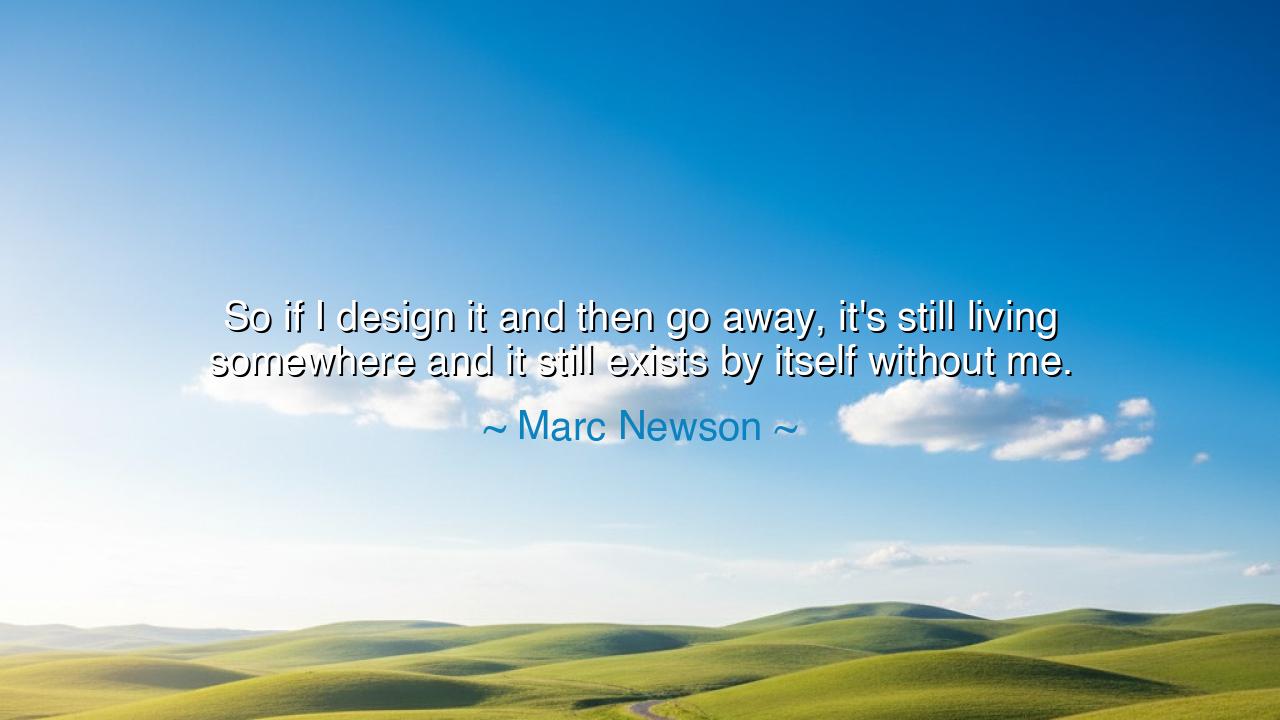
So if I design it and then go away, it's still living somewhere
So if I design it and then go away, it's still living somewhere and it still exists by itself without me.






“So if I design it and then go away, it’s still living somewhere and it still exists by itself without me.” Thus spoke Marc Newson, the modern craftsman and creator, whose hands shape not merely objects but enduring forms of beauty. In these simple words, he reveals an eternal truth known to all artists, builders, and thinkers since the dawn of creation: that true design, when born of spirit and intention, takes on a life of its own. Once the creator releases it into the world, it ceases to be merely a work — it becomes a being, a presence, a vessel of meaning that continues to breathe long after its maker has stepped away.
In this reflection, Newson does not speak only of furniture, or of the sleek forms for which he is famed. He speaks of the sacred mystery of creation — the moment when a thing crafted by human thought gains independence, when it no longer needs its maker to affirm its worth. This is the dream of all who labor with imagination: to fashion something that lives beyond them, that endures, influences, and speaks in silence to generations yet unborn. For what is design, or art, or even knowledge, if it vanishes with its creator? The true work of the spirit, once made manifest, becomes part of the living world.
The origin of this quote lies in Marc Newson’s philosophy of design — one that unites the precision of engineering with the poetry of art. To him, an object must not merely function; it must possess soul, it must breathe, it must dwell in harmony with its surroundings. When he says, “it still lives somewhere,” he points to the idea that design, once complete, enters the great continuum of culture. It travels through homes, through time, through lives — quietly shaping how people move, think, and feel. The chair one sits upon, the watch one wears, the curve of a plane’s interior — all these hold a designer’s unseen whisper. Yet the work no longer belongs to him; it belongs to life itself.
So it has been since the beginning of human craft. The pyramids of Egypt still stand, their makers long gone; the words of Homer still sing across the ages, though the man himself has turned to dust. Consider the story of Leonardo da Vinci, whose designs — flying machines, bridges, and inventions — lay dormant for centuries before their time. Leonardo left them behind, yet they lived on, breathing inspiration into future minds who would one day bring them to life. In each of these works, we see the truth of Newson’s insight: that creation is an act of immortality. What we make with purpose and love continues to live even when we no longer do.
And yet, this saying carries also a lesson in humility. For when we create, we must learn to let go. The true artist, like the gardener, must plant and release — trusting that the seed will grow as it is meant to. Too many cling to their works, fearing change, fearing that others might interpret them differently. But Newson’s wisdom teaches that once a design leaves the maker’s hand, it belongs to the world. It will be touched by time, by people, by meaning beyond what the maker imagined. The wise creator does not resist this; he rejoices in it, for it is proof that his creation is alive.
This truth extends far beyond the realm of design. Every action, every word, every kindness we perform ripples through the world in unseen ways. Our deeds are our designs, and they too live on after we depart. A teacher’s lesson may shape a mind that one day changes history; a craftsman’s hands may build a home that shelters love for generations. Even the smallest act, if born of care, carries a spark of life that endures. To live meaningfully, then, is to design not only with tools, but with intention — to leave behind what will continue to serve, to uplift, to speak.
Therefore, the lesson of Marc Newson’s words is this: create as though you will one day vanish, but your work will remain forever. Do not seek control or glory; seek endurance and purpose. Let your works — whether they be designs, relationships, or dreams — stand on their own, carrying forward the breath of your spirit. For the truest measure of creation is not in its moment of making, but in its ability to live without you.
And so, when your time comes to step away from your labor, do so with peace. Know that what you have made — if made with sincerity, vision, and love — will continue to live “somewhere,” shaping the world as quietly and powerfully as sunlight shapes the dawn. In this way, like all true creators, you too will become eternal through your work.






AAdministratorAdministrator
Welcome, honored guests. Please leave a comment, we will respond soon